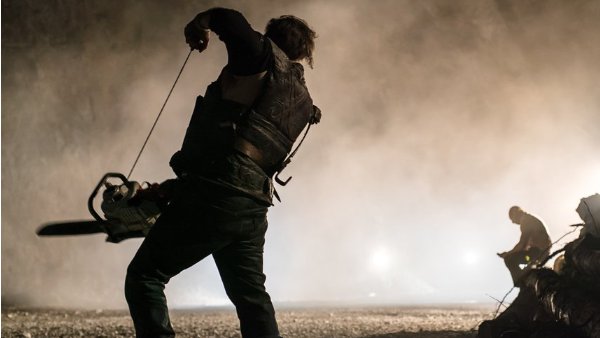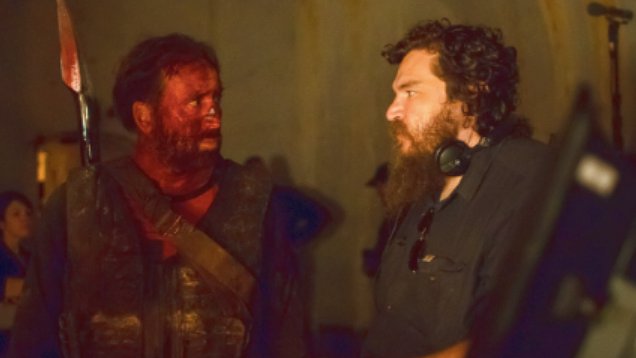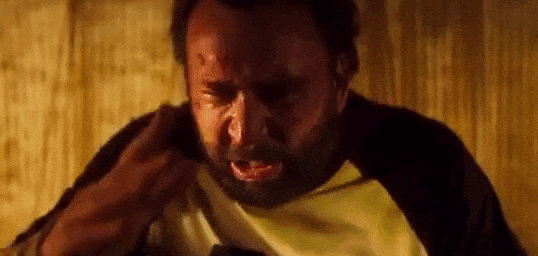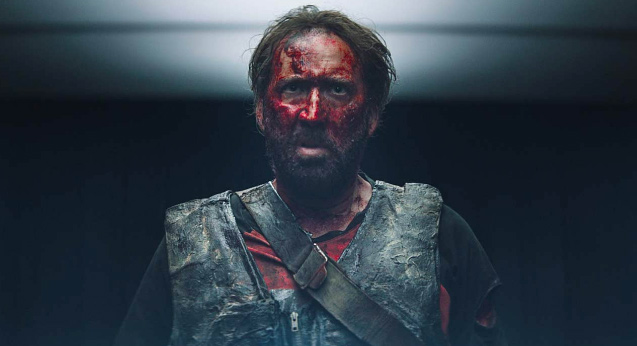Interview: How Mandy director Panos Cosmatos turned a dream about Nic Cage into one of the year’s weirdest films

In Mandy, a guy and girl meet, fall in love and carve out a quiet but happy existence. Then a van filled with crazy cult members drives through the couple’s lives, and nothing is ever the same again.
The film’s narrative might sound broadly familiar; however Mandy is its own singular creation. Directed and co-written by Beyond the Black Rainbow’s Panos Cosmatos, it’s a feverish love story, an over-the-top vengeance flick and a statement against male entitlement. It’s drenched in lurid colours, drones with a heavy synth score, and feels like it exists partway between a dream and a nightmare. Oh, and it involves demonic bikers and a cheddar goblin.
Mandy is also the latest addition to Nicolas Cage’s ever-growing resume, with the actor putting in one of his most memorable performances. When Mandy (Andrea Riseborough) is snatched up by cult leader Jeremiah Sands (Linus Roache), lumberjack Red Miller (Cage) has no choice but to act. Cage plays Red like a man possessed.

With Mandy screening in Australian cinemas on September 21, I spoke with Cosmatos about dreaming about Nicolas Cage, the timeliness of the film’s tale, and making a weird and wild movie.
SARAH: Where did the idea for Mandy come from?
PANOS: I ended up watching all of the Death Wish movies in one sitting. When you watch all the movies in a genre or a series all at one time, it gives you the chance to reflect on what makes the genre interesting or what you could change about it. Your imagination has room to drift around and to explore certain concepts if you’re in the one realm for a very long time.
So I landed on this thought of making a revenge move that orbited around the essence of the person who is being avenged, as much as it was the story of the person who was the avenger. A movie that’s kind of like a love song – or even just a song about this person – as much as it was anything else. Or an album about them, a concept album.
I wanted to keep it tied to the core approach of the genre, while at the same time bringing out the importance of the person that’s at the centre.

SARAH: It feels inconceivable to imagine Mandy with anyone other than Nicolas Cage as Red Miller. Was that a realisation that you came to yourself – and how did Nicolas Cage become involved?
PANOS: It was a long process from my perspective. I had gotten attached to this idea of him playing Jeremiah – I really wanted to see him play a really evil character, which I felt he hadn’t done in a long time, and I was very curious to see if he’d do it.
Eventually I was able to meet with him, and I could tell he was interested in playing Red. And as I talked with him, he said, “I want to play Red Miller”. For me, I felt broadsided. I didn’t expect that, I wasn’t prepared for it – it just became a non-starter. I enjoyed talking to him, and he seemed like a very interesting person, but I was so fixated on the idea of the villain that I shut that down right away in my mind.
Weeks or months later, I had a dream where he was playing Red Miller. I was watching a finished portion of Mandy in my dream, and he was playing Red Miller, and it was so undeniable how interesting he was in the role. I woke up and it was like the gods had spoken. My id had come to the rescue and said, “you’re being a moron! Cage would be amazing in this role!”. And I can’t imagine anyone else playing it now. I feel very fortunate that I came to my senses and he was still willing to do it. As a fan, it’s one of my favourite performances of his.

SARAH: Cage has a number of iconic characters and performances on his resume. When you finally cast him as Red, what were you looking for from him?
PANOS: In the specifics, it was very different, but on the broader level, it was the same as what I wanted to do with the part of the villain – which was that I always felt that he was an actor with an incredibly wide range of ability. That he could be soft and intimate and relatable, and then from there obviously grow all the way out to this absurdist level of almost dada-esque expressionism. But he also had the ability to make that absurdity feel human and tethered to the core psychology and emotion of the character.
So I got really excited about the breadth of that character, and to express that. The first thing we did when we sat down was chart the path of the character from a regular man, to regressing to where his inner spirit is more exposed – to this raw nerve, animalistic kind of person – and from there to this almost demi-god avenger who’s enacting Mandy’s will on the mortal plane.
SARAH: Red Miller is Mandy‘s protagonist, but Mandy is such a compelling force in the film – the audience always understands Red’s devotion to her. How did you approach the character of Mandy?
PANOS: I wanted her to be integral to the film. Even though she’s not in the second half as much, I wanted the audience to feel her absence – I wanted them to learn to love her as a human being, and to really feel, on a visceral level, her absence in the film.

That’s one of the reasons that I wanted to dwell and linger on her and Red in the setup of the film for as long it does – in the start of the film, in the first half of the film – to make her essence second nature to the audience, so they’d really feel when she was gone.
Also, I wanted to explore this idea, via her reactions, to this sense of the grotesque male ego – where certain men have a tendency to build up a certain fantasy versions of themselves, where they’re essentially delusional. And how dangerous it can be when that is stripped away, and they’re forced to look at themselves how they really are – and how averse men are to that.
SARAH: Do you think there’s a sense of timeliness to Mandy’s story – of a woman victimised simply for being in the wrong place at the wrong time, but refusing to fit the standard image of the victim?
PANOS: As we were preparing the film and Trump became President – as he was running, before he even won – I looked at him and I looked at Pence. And I thought that Jeremiah Sand is, in a way, if you took Trump and Pence and put them in the telepod from The Fly, this is what would come out the other end.
I think a lot about dark probabilities and worst possible outcomes just by my nature, and by what stories that I’m interested in telling. And the way the world has gone with the sort of abject hatred for women, and this sense of men feeling this entitlement – it’s a really horrific level of bizarre entitlement. They feel threatened by women being on the same level as them, to the point where they want the entire world to regress 100 years, or they going on a killing spree targeted personally at women. It’s horrifying.
SARAH: Mandy feels like it’s saturating the audience — in colour, in Johan Johansson’s score and, in the process, in Red and Mandy’s ordeal. Was that your intention?
PANOS: One of the things I started to realise when I started to conceive of both Black Rainbow and Mandy was that I wanted to make these very rich visual and sonic films that were as much audio-visual experiences as they were the telling of the stories. I went and did Black Rainbow, and I experimented with that, and it actually ended up manifesting in a way that was more interesting to me than I had originally anticipated, so that gave me the will and confidence to go even further with Mandy.
Essentially, I want my films to have a very tactile visual and sonic quality to them — that they’re almost juicy.
SARAH: Do you think that’s something that’s not focused on as much in filmmaking these days – that film is being seen more as a vehicle for telling stories, and less as a sensory experience that comes from sound and vision?
PANOS: Absolutely. There are filmmakers who have that quality, but for me, one of the core principles that interests me in the process of creating a film is making it an audio-visual treat.
















